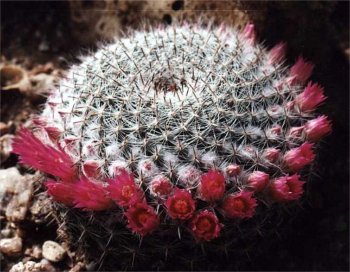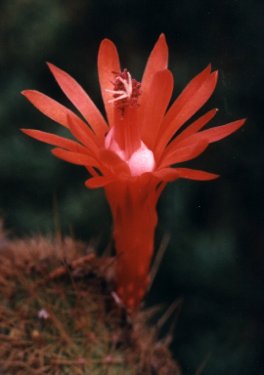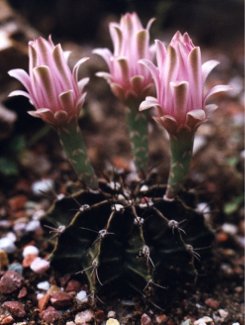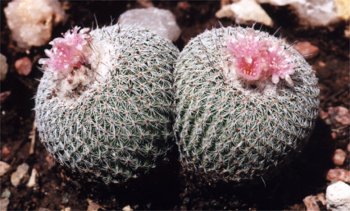Cactus Blooms I
by Valerie (September 2, 2000)
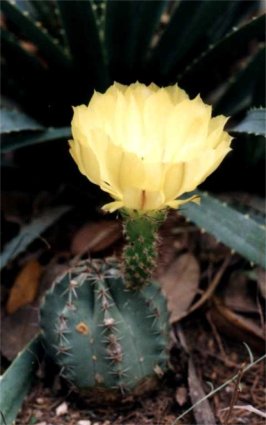
We grow a lot of different cactuses. Our climate and growing conditions make the exclusion of large numbers of succulents seem almost a blatant insult to Mother Nature. I tried to grow cactuses in pots, but they were never very happy and, in fact, quite a few didn't survive very long. I'm just not too adept at the intricacies of providing for domesticated plants. We began planting desert plants such as agaves, yuccas and cactuses at least 12 years ago and quickly discovered that more cactuses could survive our winters than we had thought possible. I experimented with a few of the inexpensive tiny cactuses sold at local discount stores and found that with a little protection, they could survive the freezes, and, indeed, the extra hot, dry conditions of summer made them grow very well. There are some species that can't take all that much direct sun, but the majority thrive. Perhaps the biggest problem is overcrowding, especially by large aloes, agaves and yuccas, which grow quite a bit faster than most cactuses. I've had to relocate a number of plants because they were being squished.
An example of this occurred with the first cactus (Echinocereus subinermis) shown here. This Mexican native seemed to have a delicate skin and few spines so I gave it a protected position in the shade of a young yucca, which can be seen in the background. It did well for a few years, needing no extra care to survive and producing a flower each spring. However, the yucca soon grew much bigger and, by the time I got around to rescuing the small cactus, it was already beginning to rot out at the bottom and one side. After cutting away the damage, I relocated it a couple of years ago to a raised bed garden that we have turned into a cactus and succulent area. It then produced double blossoms, shown below. It also had one offshoot, which is now doing well in full sun as well.
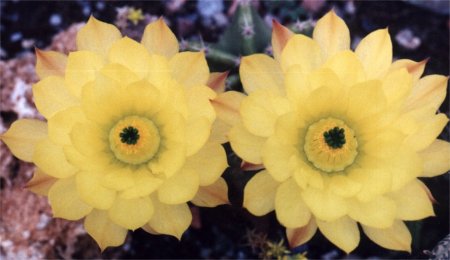
The cactuses in the raised bed do better than the few scattered in our other gardens. This area gets full sun between about 9:00 a.m. and 3:00 p.m. during the summer and from dawn (the deciduous trees have lost their leaves) until early afternoon in the winter. The size of the garden is 12' x 4' x 1½' with the sides being made of landscape logs. It was created about nine years ago and is holding up well in spite of termite and carpenter ant infestations. It was turned into a cactus garden two years ago and during the winter can easily be covered with a tarp when temperatures are predicted to get below freezing. We expect to lose plants to freezing and burning every so often (and currently we are having a record number of days with the temperature over 100°F) and have lost a couple this summer, but last winter was extremely mild.
One surprise has been that a number of cactuses bloom during the winter and the Mammillaria species pictured here did just that. This cactus started with just a few blossoms, but gradually a whole ring developed. It bloomed continuously for about two months. I'm not positive of the identification of this plant; it might be Mammillaria hahniana or Mammillaria formosa or perhaps something else. Genus is certain.
While the majority of our cactuses live outside year 'round, a few still remain in pots and are put out in the sunniest parts of one garden early in the spring, to remain until we get a freeze warning during late fall, at which time we bring them into the house. One of these is a sprawling, long-stemmed and thickly-spined cactus with no common name (Hildewintera aureispina). It resembles a very robust version of the popular peanut cactus and its blossoms are red as well, but with a slightly different shape. It has only produced flowers one to two at a time but it's capable of producing more. This cactus has more synonymous Genus names than most plants have common names: Loxanthocereus, Winterocereus, Winteria, and Cleistocactus.
The cactus (Gymnocalycium mihanovichii) shown at right is just ready to bloom. Most cactus blossoms last only one day or night, but the bud formation and, sometimes, the seed pod formation take much longer. As the tiny bud grows bigger and bigger, then finally bursts open, it sort of like watching slow-motion fireworks. And because we never know which cactus will bloom next, the scattered effect adds to this analogy. This Paraguayan cactus is very common in the bargain baby cactus sections of most plant nurseries and it is also the species used to produce the red grafted cactus that is on normal, green stock. The red is produced by subjecting the normal cactuses to gamma rays to eliminate chlorophyll. The red version can produce flowers but not roots, and can't feed itself and so lives off the stock onto which it is grafted. The flowers of the button cactus, or mulato (Epithelantha micromeris), are so small that they are hard to see. The delicate pink color seems to fit right in with the fine, tiny spines that cover this small Mexican cactus. The fruits which follow are much more noticeable, being long and bright red.
While some cactuses bloom with only one flower at a time, others put out a display of many. This cactus (Weingartia lanata) from Bolivia grew rather quickly after we purchased it, and blooms again and again during the spring and early summer. At first it had just one or two blossoms, but now regularly produces a large number of bright yellow blooms.
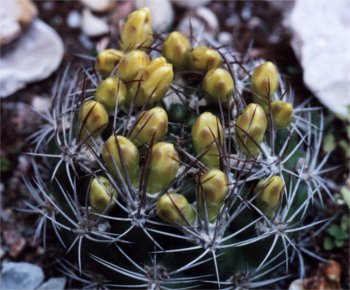
|
